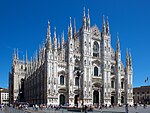Teatro Lirico (Milan)
Music in MilanTheatres completed in 1779Theatres in MilanTourist attractions in Milan

The Teatro Lirico (known until 1894 as the Teatro alla Canobbiana) is a theatre in Milan, Italy. In the 19th and early 20th centuries it hosted numerous opera performances, including the world premieres of Donizetti's L'elisir d'amore and Giordano's Fedora. The theatre, located on Via Rastrelli, closed in 1998. However, a restoration project was begun in April 2007, and it has finally re-opened in December 2021 as the Teatro Lirico Giorgio Gaber. Stage Entertainment carried on the renovation of the Theatre, completing all finishes and all workings started by the administration "Comune di Milano".
Excerpt from the Wikipedia article Teatro Lirico (Milan) (License: CC BY-SA 3.0, Authors, Images).Teatro Lirico (Milan)
Via Larga, Milan Municipio 1
Geographical coordinates (GPS) Address External links Nearby Places Show on map
Geographical coordinates (GPS)
| Latitude | Longitude |
|---|---|
| N 45.461497222222 ° | E 9.1918222222222 ° |
Address
Teatro Lirico Giorgio Gaber (Teatro lirico Giorgio Gaber)
Via Larga 14
20122 Milan, Municipio 1
Lombardy, Italy
Open on Google Maps










